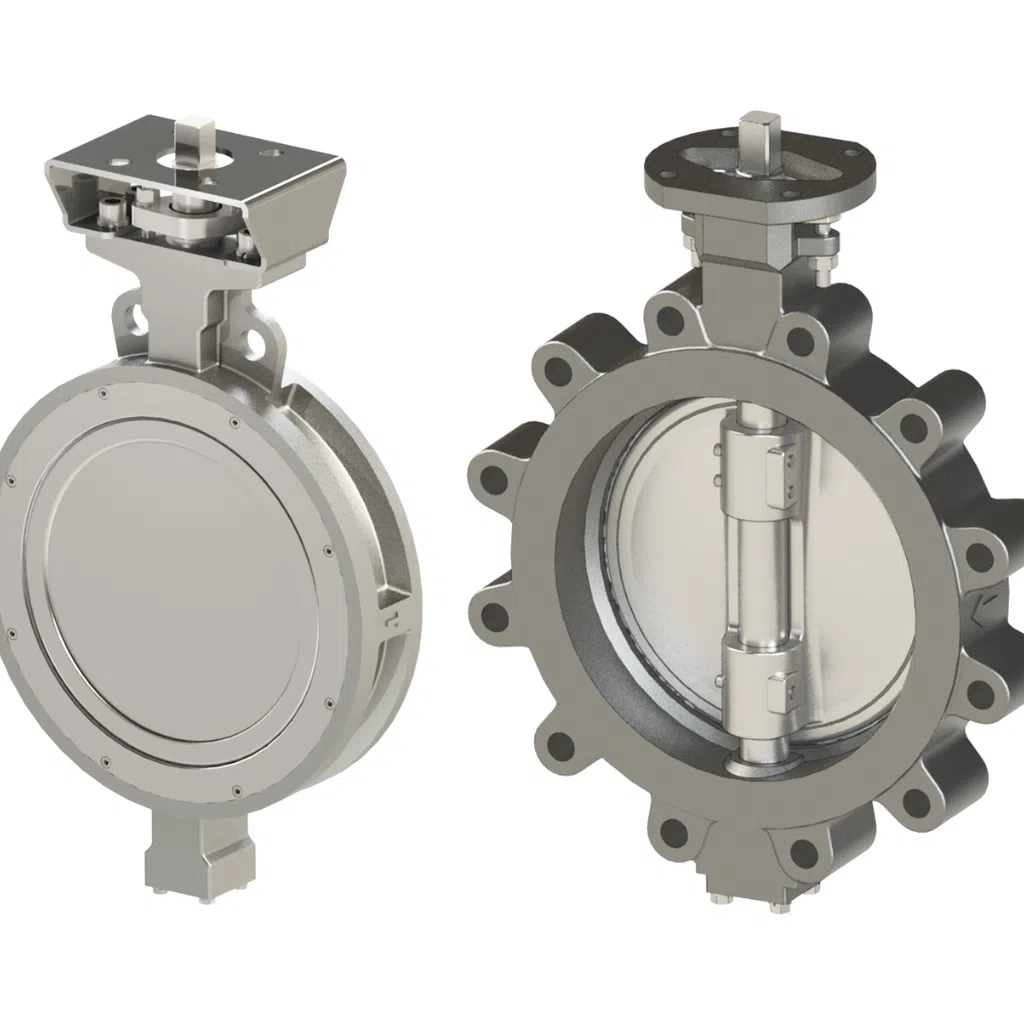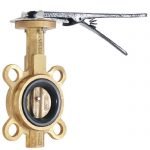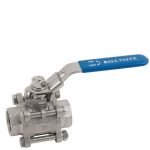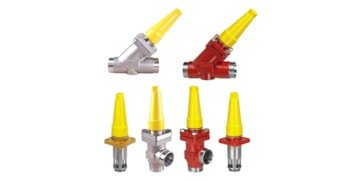A marine butterfly valve is a quarter-turn valve used for isolating or regulating the flow of fluids. It is named for its disc, or “butterfly,” which rotates a quarter turn (90 degrees) on a central axis to open or close. Butterfly valves are highly valued in marine applications for their lightweight, compact design, fast operation, and lower cost compared to other valve types.1
Working Principle and Design
A butterfly valve consists of a circular disc (the “butterfly”) positioned in the center of the pipe.2
- Open/Close Mechanism: When the valve is open, the disc is turned parallel to the flow, creating a minimal obstruction.3 When the valve is closed, the disc is turned perpendicular to the flow, and a soft seal (the seat) provides a tight shut-off against the disc.
- Quarter-Turn Operation: A simple 90-degree turn of the handle or actuator is all that is needed to fully open or close the valve, making for very quick operation.4
- Low Pressure Drop: The design allows for a relatively straight flow path, resulting in a low pressure drop.5 However, even when fully open, the disc remains in the flow path, causing some pressure loss.6
Main Types for Marine Applications
Butterfly valves come in several configurations to suit different installation needs:
- Wafer-Type: The most common type. It has no flanges of its own and is clamped between two pipe flanges using long bolts that pass through both flanges and the valve body. It is lightweight and easy to install.7
- Lug-Type: Similar to the wafer type but with threaded bolt holes (lugs) on the valve body.8 This allows the valve to be installed at the end of a pipe run or easily removed for maintenance without disturbing the other side of the pipeline.9
- Double-Flanged Type: A more robust and heavier design with flanges on both ends.10 This is used for larger bore sizes and higher-pressure applications where a secure, bolted connection is required on both sides.
- Concentric vs. Eccentric:
- Concentric: The disc is centered in the bore and seals with a soft seat.11 This is the most common and cost-effective type.
- Eccentric: The disc is positioned offset from the stem. This design reduces seat wear, improves sealing, and is used for more demanding applications.12
- Concentric: The disc is centered in the bore and seals with a soft seat.11 This is the most common and cost-effective type.
Applications and Materials
Due to their versatility, butterfly valves are used in many marine systems, particularly for large-diameter pipes.
- Common Applications on a Ship:
- Ballast and Bilge Systems: For on/off control of seawater.
- Seawater Cooling Systems: For isolating large cooling lines.
- Fire Fighting Systems: For quick shut-off control.
- General Service Water Lines: For fresh and saltwater systems.
- Materials:
- Body: The body is often made of cast iron or ductile iron for strength and cost-effectiveness.13
- Disc: The disc is typically made of corrosion-resistant materials like bronze, aluminum bronze, stainless steel, or even coated materials.14
- Seat: The seat, which provides the seal, is a replaceable soft liner made of a durable rubber compound like EPDM (ethylene propylene diene monomer) or Nitrile (Buna-N).15
- Body: The body is often made of cast iron or ductile iron for strength and cost-effectiveness.13
Maintenance and Common Issues
Maintenance of butterfly valves is generally simple, focusing on the seal.
- Routine Maintenance:
- Check for Leaks: Inspect the valve body and stem seals for any leaks.
- Operate Periodically: Exercise the valve to prevent the disc from seizing or becoming stuck in the seat.
- Common Issues:
- Seat Wear: The rubber seat can become compressed or damaged, leading to leakage.
- Disc Damage: The disc can be damaged by foreign debris in the line.
- Stem Seal Leaks: Leaks can occur where the stem penetrates the valve body.
Spare Parts
A vessel’s spares inventory for butterfly valves should include:
- Seat Liners: A complete replacement seat liner is the most important spare part, as this is the primary wear component.
- Stem Seals: Gaskets and O-rings for the stem.
- Discs: A spare disc may be required in case of damage.
- Actuator Spares: Spare gears or pneumatic/hydraulic parts for automated valves.
Butterfly valves are an efficient and practical solution for a wide range of marine fluid handling applications.16
We offer an extensive range of marine engine brands and their associated spare parts, providing comprehensive solutions for both main propulsion and auxiliary power needs across diverse vessel types. Our supply capability covers various generations and models, ensuring support for a wide array of marine applications.
Featured Brands and Engine Series/Models:
SULZER:
- Two-Stroke Engines:
- RD/RND Series: RD68, RND76, RND76M, RND90, RND90M (Classic large-bore, low-speed engines, still in operation).
- RLA/RLB Series: RLA(B)56, RLA(B)66, RLA(B)76, RLB90 (Developed two-stroke designs).
- RTA/RT-Flex Series: RTA38, RTA48(T), RTA52, RTA58, RTA62, RTA72, RTA76, RTA84, RTA84M, RTA84C, RTA96 (Modern, fuel-efficient, electronically controlled two-stroke engines).
- Four-Stroke Engines:
- Z Series: ZL40/48, 16ZAV40S (Medium-speed engines).
- RF Series: RF44, RF56 (Often used for auxiliary power or generator sets).
- TAD Series: TAD36, TAD48 (For specific applications).
MAN (including pre and post-MAN B&W models):
- Two-Stroke Engines (KZ, KSZ, K, L, S, MC/MC-C, ME/ME-C): 40/54A, 52/90N, 57/80C, KZ57/80F, KSZ70/125, KSZ78/155, 90/160A, 52/55L, 58/64, 90/190C, L60/105E, 70/120E, 70/125C, L, KSZ78/155A, KSZ70/125B, L52/55A, 40/45 (A broad spectrum covering main propulsion and auxiliary engines).
B&W (Burmeister & Wain – prior to MAN B&W merger):
- MC/MCE Series: L35MC, L60MC, L80MC, L55GFCA, L80GFCA, L80GB, 74VT2BF, K62EF, K74EF, K84EF, K45GFC, K67GFK, K80GFK, K90GFS, 45HU, L70MC (Various generations of two-stroke diesel engines).
- MC-C/ME-C Series: L50MC, S60MC, S70MC, K80MC, S80MC, K90MC-C, L67GFCA, L90GB (Electronically controlled and conventional two-stroke engines).
- VT2BF/EF Series: 50VT2BF, 62VT2BF, K84EF (Older models still in service).
MITSUBISHI:
- UEC/UET Series: UEC37L/LA/LS, UEC45HA, UEC60L/LA/LS, UEC45L/LA/LS, UET45/75C, UEC52/125H, UEC52L/LA/LS, UET45/80D, UEC52/90D, UEC(T)52/105D, UEC45/115H, UEC37/88H, UEC37H (Mitsubishi’s proprietary two-stroke and some four-stroke engine series).
PIELSTICK:
- PA Series: PA6, PC3, PC2-2, IHI PC2-5, PC4, PC2-6, PC4-2L, PC4-570, PA5 (High-speed, compact four-stroke engines, commonly used for generator sets or auxiliary propulsion).
AKASAKA:
- UET/UEC/DM/AH Series: UET45/80D, UEC52/105D, DM51SS, UEC 60/150H, UEC 60H, A31, A34, A37, A41, AH27, AH28, AH30, AH36, AH38, AH40, DM30, DM36, DM38, DM46, DM47 (A prevalent engine brand, particularly in Japanese-built vessels).
DEUTZ:
- RBV/TBD/BVM Series: RBV8M358, RBV8M540, RBV16M640, TBD620L6, BVM350, BVM540, BF6M716 (Various four-stroke medium- and high-speed diesel engines for auxiliary and smaller main propulsion applications).
HANSHIN:
- EL/LH/LU/LUN/LUD/LUS Series: EL30, EL32, EL35, EL40, EL44, LH28RG, LH31G, LU28(A,R,G), LU32, LU35, LU38, LU46(A), LU50, LU54, LUN28, LUN30, LUD32, LUD35, LUS38 (Another significant engine brand commonly found in Japanese vessels).
NIIGATA:
- MG/M Series: MG40X(EX), M34X, 6M28BF, TM31X (Medium-speed diesel engines, typically used in small and medium-sized vessels).
MAK:
- M/MU/AK/AKM Series: M332, M453AK, MU551AK, MU552AK, M601, MU452AK, 451AK, 6M453AK, 9M453C, 6M601C, 8M601 (Medium-speed four-stroke engines, widely used in various marine applications).
WARTSILA:
- 20/22/26/32/38/46/GD/TKR Series: 22, 32, 31, 26, 20S, 28, 38, 46, 32GD, 46GD, 14, TKR22, HFR-V32, NOHAB (Wärtsilä’s broad portfolio of medium- and high-speed diesel engines for main propulsion, auxiliary, and generator sets).
DAIHATSU:
- PS/PKT/DS/DL/DK/PL Series: PS-18, PS-22, PS-20, PS-26, PS-30, PKT-14, PKT-16, PKTD-16, DS-18, DS-22, DS-26, DS-28, DS-32, DL-14, DL-16, DL-19, DL-20, DL-22, DL-24, DL-26, DK-20, PL-24 (Compact and reliable engines primarily used for auxiliary power and generator sets).
CUMMINS:
- BT/CT/NT/KTA/QSK/QSM Series: 4BT3.9, 6BT(A)5.9, 6CT8.3, NT(A)855, N14, KTA19, KTA38, KTA50, QSK19, QSM11 (Robust and durable engines for marine auxiliary power, generator sets, and some smaller main propulsion applications).
CATERPILLAR:
- 3000/3100/3300/3400/3500/3600 Series & C Series: 3054, 3056, 3066, 3106, 3126, 3306, 3406, 3408, 3412, 3508, 3512, 3516, 3606, 3608, 3612, 3616, 3618, C1.5, C2.2, C7, C9, C10, C12, C15, C16, C18, C30, C32 (Reliable and widely used engines across a vast range of main propulsion, auxiliary, and generator set applications).
SCANIA:
- DI Series: DI 09, DI 13, DI 16 (High-performance diesel engines designed for marine applications, typically used as auxiliary and smaller main propulsion engines).




